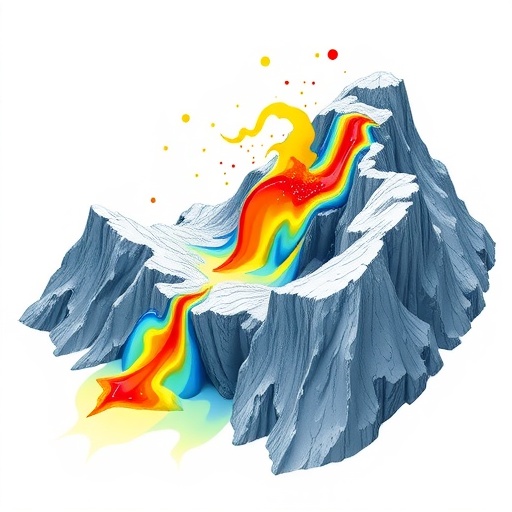In an era defined by technological advancement and complex engineering challenges, understanding the phenomena associated with rockbursts remains a critical endeavor. Rockbursts, sudden and violent releases of energy from rock formations, pose significant risks not only to underground workers but also to the stability of mining operations. The recent research by Cai, Chen, Rui, and their colleagues, published in the prestigious journal Natural Resources Research, delves into the intricate field of rockburst severity prediction under few-shot learning conditions using a cutting-edge feature fusion approach. This innovative methodology aims to enhance the prediction accuracy of rockburst occurrences, ultimately contributing to safer mining practices.
The research addresses a notable gap in rockburst prediction methodologies, particularly concerning the scarce availability of labeled data. Traditional machine learning approaches rely heavily on vast datasets for training, which can be challenging to obtain in specific geological contexts. This study pioneers the use of few-shot learning, which can train models effectively with very limited samples. By leveraging prior knowledge gained from extensive datasets, the authors present a robust way to develop accurate predictive models, potentially transforming the approach to rockburst risk management in mining sectors.
Cai and his colleagues meticulously detail their feature fusion learning technique, which synthesizes various data types to enhance the model’s predictive capabilities. They collect various geological and operational data, including stress measurements, seismic readings, geological features, and mining activity logs. By synergizing these diverse data sources, they establish a comprehensive feature set that significantly aids in accurately predicting the severity of rockbursts. This highlight of feature fusion not only improves predictive performance but also underscores the importance of interdisciplinary approaches in tackling geological hazards.
One of the remarkable aspects of the study is its validation phase, where the proposed model is applied to real-world scenarios. By integrating data from multiple mining sites known for their susceptibility to rockbursts, the researchers meticulously test the efficacy of their model. The results demonstrate a marked improvement in predictive accuracy when compared to existing methodologies, suggesting that the integration of few-shot learning into rockburst prediction frameworks could redefine standard practices in the field.
The implications of this research extend beyond mere academic interest; they carry substantial real-world significance. Safer mining operations can lead to reduced injuries and fatalities, lower operational costs stemming from unpredicted rockbursts, and improved stability in mining production. By embracing the researchers’ findings, mining companies may enhance their ability to anticipate hazardous conditions, prompting timely interventions that safeguard both personnel and investments.
Moreover, the study emphasizes a significant shift towards data-driven decision-making processes in geology and mining. The large-scale collection of data, coupled with advanced analytics and machine learning, holds the potential to revolutionize how geohazards are understood and managed. By making rockburst prediction more precise and reliable, industries can foster a culture of safety that prioritizes the protection of workers while also maintaining productivity.
Cai et al.’s exploration of few-shot learning introduces a versatile framework that could potentially be adapted to various geological hazards beyond rockbursts. This adaptability opens avenues for future research that could target other perilous phenomena such as landslides and earthquakes. The convergence of machine learning techniques with geological challenges highlights the need for continued research efforts and collaboration among experts across disciplines.
Furthermore, the potential for real-time predictive analytics utilizing these advanced methodologies cannot be overlooked. As technological infrastructure within mines becomes increasingly sophisticated, integrating predictive models capable of processing incoming data continuously could lead to proactive risk management strategies. This foresight into potential rockburst events could contribute to not only enhanced safety but also more efficient operational planning.
In conclusion, the groundbreaking work by Cai, Chen, Rui, and their colleagues marks a pivotal moment in rockburst research, offering a sophisticated approach to a problem that has long plagued the mining industry. Their innovative feature fusion learning model showcases not only the potential of few-shot learning in a field historically constrained by data scarcity but also sets a precedent for future research endeavors. As the mining sector continues to evolve, strategies grounded in rigorous, data-driven methodologies will be essential for ensuring the safety and sustainability of operations worldwide.
By fostering an environment that embraces technological advancements and interdisciplinary collaboration, the research community can drive meaningful progress in geological safety. This study serves as a clarion call to both researchers and industry practitioners alike, encouraging a concerted effort towards enhancing predictive capabilities and ultimately creating safer mining environments. The journey of rockburst prediction has taken on renewed urgency, prompting a host of new research questions and practical applications that are set to shape the future landscape of mining and geological hazard management.
The urgency to tackle rockburst prediction highlights the intertwining of theoretical advancements and practical applications. With the insights gained from this research, it’s clear that a data-centric approach – powered by feature fusion and few-shot learning – can spell the difference between erratic risk and systematic safety protocols in mining operations. The strides made in this area affirm a future where technology and geological sciences converge, paving the way for a more secure, efficient, and responsive mining industry.
In conclusion, Cai et al.’s exploration of rockburst severity prediction not only provides a roadmap for more effective safety measures in mines but also illustrates the broader implications of leveraging machine learning in resource extraction. The success of their approach may well inspire further inquiries into the intricacies of geological risks and how advanced computational techniques can mitigate them. As industries face increasingly complex challenges in extraction and safety, research outcomes such as these will undoubtedly chart pathways toward resilience and innovation in the field.
Subject of Research: Rockburst severity prediction using few-shot learning and feature fusion.
Article Title: Rockburst Severity Prediction Under Few-Shot Conditions Using Feature Fusion Learning.
Article References:
Cai, X., Chen, L., Rui, Y. et al. Rockburst Severity Prediction Under Few-Shot Conditions Using Feature Fusion Learning.
Nat Resour Res 34, 2877–2898 (2025). https://doi.org/10.1007/s11053-025-10529-3
Image Credits: AI Generated
DOI: https://doi.org/10.1007/s11053-025-10529-3
Keywords: Rockburst, prediction, few-shot learning, feature fusion, mining safety, geological hazard management.




